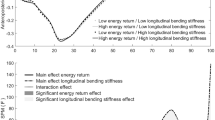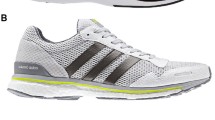Abstract
Background
Shoe longitudinal bending stiffness is known to influence running economy (RE). Recent studies showed divergent results ranging from 3% deterioration to 3% improvement in RE when bending stiffness increases. The variability of these results highlights inter-individual differences. Thus, our purpose was to study the runner-specific metabolic responses to changes in shoe bending stiffness.
Methods
After assessing their maximal oxygen consumption (\({\dot{\text{V}}\text{O}}_{{^{2} }}\) max) and aerobic speed (MAS) during a first visit, 96 heterogeneous runners performed two treadmill 5 min runs at 75% \({\dot{\text{V}}\text{O}}_{{^{2} }}\) max with two different prototypes of shoes on a second day. Prototypes differed only by their forefoot bending stiffness (17 N/mm vs. 10.4 N/mm). RE and stride kinematics were recorded during each trial. A clustering analysis was computed by comparing the measured RE and the technical measurement error of our gas exchange analyzer to identify functional groups of runners, i.e., responding similarly to footwear interventions. ANOVAs were then computed on biomechanical and morphological variables to compare the functional groups.
Results
Considering the whole sample (n = 96), there was no significant difference in RE between the two conditions. Cluster 1 (n = 29) improves RE in the stiffest condition (2.7 ± 2.1%). Cluster 2 (n = 26) impairs RE in the stiffest condition (2.7 ± 1.3%). Cluster 3 (n = 41) demonstrated no change in RE (0.28 ± 0.65%). Cluster 1 demonstrated 1.7 km·h−1 greater MAS compared to cluster 2 (p = 0.014).
Conclusion
The present study highlights that the effect of shoe bending stiffness on RE is runner-specific. High-level runners took advantage of increased bending stiffness, whereas medium-level runners did not. Finally, this study emphasizes the importance of individual response examination to understand the effect of footwear on runner’s performance.




Similar content being viewed by others
References
Barnes KR, Kilding AE (2019) A Randomized crossover study investigating the running economy of highly-trained male and female distance runners in marathon racing shoes versus track spikes. Sports Med 49:331–342. https://doi.org/10.1007/s40279-018-1012-3
Beck O, Golyski P, Sawicki G (2020a) Adding carbon fiber to shoe soles may not improve running economy: a muscle-level explanation. Sci Rep. https://doi.org/10.1038/s41598-020-74097-7
Beck ON, Golyski PR, Sawicki GS (2020b) Adding carbon fiber to shoe soles may not improve running economy: a muscle-level explanation. Sci Rep 10:17154. https://doi.org/10.1038/s41598-020-74097-7
Brockway JM (1987) Derivation of formulae used to calculate energy expenditure in man. Hum Nutr Clin Nutr 41:463–471
Burns GT, Tam N (2020) Is it the shoes? A simple proposal for regulating footwear in road running. Br J Sports Med 54:439–440. https://doi.org/10.1136/bjsports-2018-100480
Cigoja S, Fletcher JR, Esposito M, Stefanyshyn DJ, Nigg BM (2021a) Increasing the midsole bending stiffness of shoes alters gastrocnemius medialis muscle function during running. Sci Rep 11:749. https://doi.org/10.1038/s41598-020-80791-3
Cigoja S, Fletcher JR, Nigg BM (2021b) Can changes in midsole bending stiffness of shoes affect the onset of joint work redistribution during a prolonged run? J Sport Health Sci. https://doi.org/10.1016/j.jshs.2020.12.007
Day EM, Hahn ME (2019) Dynamic angular stiffness about the metatarsophalangeal joint increases with running speed. Hum Mov Sci 67:102501. https://doi.org/10.1016/j.humov.2019.102501
Day E, Hahn M (2020) Optimal footwear longitudinal bending stiffness to improve running economy is speed dependent. Footwear Sci 12:3–13. https://doi.org/10.1080/19424280.2019.1696897
Flores N, Delattre N, Berton E, Rao G (2019) Does an increase in energy return and/or longitudinal bending stiffness shoe features reduce the energetic cost of running? Eur J Appl Physiol 119:429–439. https://doi.org/10.1007/s00421-018-4038-1
Franz JR, Wierzbinski CM, Kram R (2012) Metabolic cost of running barefoot versus shod: is lighter better? Med Sci Sports Exerc 44:1519–1525. https://doi.org/10.1249/MSS.0b013e3182514a88
Frederick EC (2020) No evidence of a performance advantage attributable to midsole thickness. Footwear Sci. 12:1–2. https://doi.org/10.1080/19424280.2019.1690327
Hoogkamer W (2020) More isn’t always better. Footwear Sci 12:1–3. https://doi.org/10.1080/19424280.2019.1710579
Hoogkamer W, Kipp S, Spiering BA, Kram R (2016) Altered running economy directly translates to altered distance-running performance. Med Sci Sports Exerc 48:2175–2180. https://doi.org/10.1249/MSS.0000000000001012
Hoogkamer W, Kipp S, Frank JH, Farina EM, Luo G, Kram R (2018) A comparison of the energetic cost of running in marathon racing shoes. Sports Med 48:1009–1019. https://doi.org/10.1007/s40279-017-0811-2
Hoogkamer W, Kipp S, Kram R (2019) The biomechanics of competitive male runners in three marathon racing shoes: a randomized crossover study. Sports Med 49:133–143. https://doi.org/10.1007/s40279-018-1024-z
Hopkins WG (2000) Measures of reliability in sports medicine and science. Sports Medicine (auckland, N.z.). 30:1–15
Hunter I, McLeod A, Valentine D, Low T, Ward J, Hager R (2019) Running economy, mechanics, and marathon racing shoes. J Sports Sci 37:2367–2373. https://doi.org/10.1080/02640414.2019.1633837
van Ingen Schenau, Gerrit Jan, Maarten F Bobbert, Arthur J van Soest (1990) The Unique Action of Bi-Articular Muscles in Leg Extensions. In: Jack M Winters, Savio L Y Woo (eds). Multiple Muscle Systems Biomechanics and Movement Organization, Springer, New York, p 639
Jones AM, Doust JH (1996) A 1% treadmill grade most accurately reflects the energetic cost of outdoor running. J Sports Sci 14:321–327. https://doi.org/10.1080/02640419608727717
Laumets R, Viigipuu K, Mooses K, Mäestu J, Purge P, Pehme A, Kaasik P, Mooses M (2017) Lower leg length is associated with running economy in high level caucasian distance runners. J Hum Kinet 56:229–239. https://doi.org/10.1515/hukin-2017-0040
Laura H, Hoogkamer W (2021) Longitudinal bending stiffness does not affect running economy in Nike Vaporfly shoes. J Sport Health Sci 11:285
Macfarlane DJ, Wong P (2012) Validity, reliability and stability of the portable cortex metamax 3B gas analysis system. Eur J Appl Physiol 112:2539–2547. https://doi.org/10.1007/s00421-011-2230-7
Madden R, Sakaguchi M, Tomaras EK, Wannop JW, Stefanyshyn D (2016) Forefoot bending stiffness, running economy and kinematics during overground running. Footwear Science 8:91–98. https://doi.org/10.1080/19424280.2015.1130754
Maldonado S, Mujika I, Padilla S (2002) Influence of body mass and height on the energy cost of running in highly trained middle and long-distance runners. Int J Sports Med 23:268–272. https://doi.org/10.1055/s-2002-29083
McLeod AR, Dustin Bruening A, Johnson W, Ward J, Hunter I (2020) Improving running economy through altered shoe bending stiffness across speeds. Footwear Sci 12:79–89. https://doi.org/10.1080/19424280.2020.1734870
Nigg BM, Stefanyshyn D, Cole G, Stergiou P, Miller J (2003) The effect of material characteristics of shoe soles on muscle activation and energy aspects during running. J Biomech 36:569–575. https://doi.org/10.1016/S0021-9290(02)00428-1
Oh K, Park S (2017) The bending stiffness of shoes is beneficial to running energetics if it does not disturb the natural MTP joint flexion. J Biomech 53:127–135. https://doi.org/10.1016/j.jbiomech.2017.01.014
Ortega JA, Healey LA, Swinnen W, Hoogkamer W (2021) Energetics and biomechanics of running footwear with increased longitudinal bending stiffness: a narrative review. Sports Med 51:873–894. https://doi.org/10.1007/s40279-020-01406-5
Padulo J, Annino G, Migliaccio GM, D’Ottavio S, Tihanyi JZ (2012) KINEMATICS OF RUNNING AT DIFFERENT SLOPES AND SPEEDS. J Strength Cond Res 26:9
Sanno M, Willwacher S, Epro G, Brüggemann G-P (2018) Positive work contribution shifts from distal to proximal joints during a prolonged run. Med Sci Sports Exerc 50:2507–2517. https://doi.org/10.1249/MSS.0000000000001707
Saunders PU, Pyne DB, Telford RD, Hawley JA (2004) Reliability and variability of running economy in elite distance runners. Med Sci Sports Exerc 36:1972–1976. https://doi.org/10.1249/01.mss.0000145468.17329.9f
Stefanyshyn D, Fusco C (2004) Athletics: increased shoe bending stiffness increases sprint performance. Sports Biomechanics 3:55–66. https://doi.org/10.1080/14763140408522830
Tam E, Rossi H, Moia C, Berardelli C, Rosa G, Capelli C, Ferretti G (2012) Energetics of running in top-level marathon runners from Kenya. Eur J Appl Physiol 112:3797–3806. https://doi.org/10.1007/s00421-012-2357-1
van Ingen Schenau GJ, Boots PJM, de Groot G, Snackers RJ, van Woensel WWLM (1992) The constrained control of force and position in multi-joint movements. Neuroscience 46:197–207. https://doi.org/10.1016/0306-4522(92)90019-X
van Oeveren BT, de Ruiter CJ, Beek PJ, van Dieën JH (2021) The biomechanics of running and running styles: a synthesis. Sports Biomech. https://doi.org/10.1080/14763141.2021.1873411
Williams KR, Snow R, Agruss C (1991) Changes in distance running kinematics with fatigue. Intern J Sport Biomech 7:138–162. https://doi.org/10.1123/ijsb.7.2.138
Willwacher S, Sanno M, Brüggemann G-P (2020) Fatigue matters: an intense 10 km run alters frontal and transverse plane joint kinematics in competitive and recreational adult runners. Gait Posture 76:277–283. https://doi.org/10.1016/j.gaitpost.2019.11.016
Worobets J, Wannop JW, Tomaras E, Stefanyshyn D (2014) Softer and more resilient running shoe cushioning properties enhance running economy. Footwear Science 6:147–153. https://doi.org/10.1080/19424280.2014.918184
Zdziarski LA, Chen C, Horodyski M, Vincent KR, Vincent HK (2016) Kinematic, cardiopulmonary, and metabolic responses of overweight runners while running at self-selected and standardized speeds. PM R 8:152–160. https://doi.org/10.1016/j.pmrj.2015.06.441
Acknowledgements
The authors wish to express their sincere gratitude to all the participants for participating .
Author information
Authors and Affiliations
Contributions
MC participated in the study conception, conducted the data collection and data reduction/analysis. SM, MG: participated in the study conception and contributed to interpretation of results. SP, NH: participated in the study conception. All authors contributed to the manuscript writing. Each author has read and concurs with the content in the final manuscript and agree with the order of presentation of the authors.
Corresponding author
Ethics declarations
Conflict of interest
This study was supported by Amer Sports Footwear as part of its research work. Mickael Chollet has no conflict of interest. Samuel Michelet, Nicolas Horvais, Sebastien Pavailler, and Marlene Giandolini are employees of Salomon SAS. The results of the study are presented clearly, honestly, and without fabrication, falsification, or inappropriate data manipulation. The results of the present study do not constitute endorsement by ACSM.
Additional information
Communicated by Rene Lacour.
Publisher's Note
Springer Nature remains neutral with regard to jurisdictional claims in published maps and institutional affiliations.
Rights and permissions
Springer Nature or its licensor holds exclusive rights to this article under a publishing agreement with the author(s) or other rightsholder(s); author self-archiving of the accepted manuscript version of this article is solely governed by the terms of such publishing agreement and applicable law.
About this article
Cite this article
Chollet, M., Michelet, S., Horvais, N. et al. Individual physiological responses to changes in shoe bending stiffness: a cluster analysis study on 96 runners. Eur J Appl Physiol 123, 169–177 (2023). https://doi.org/10.1007/s00421-022-05060-9
Received:
Accepted:
Published:
Issue Date:
DOI: https://doi.org/10.1007/s00421-022-05060-9




